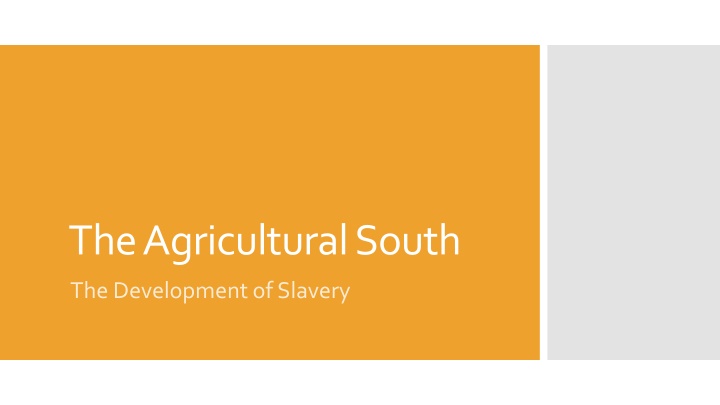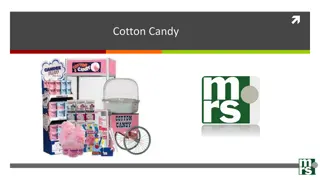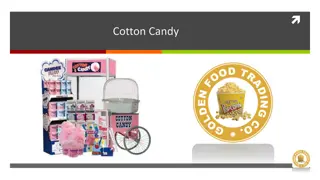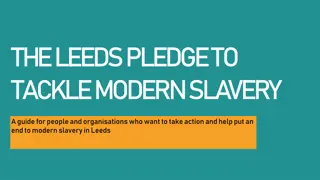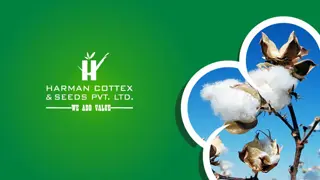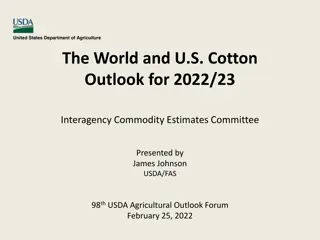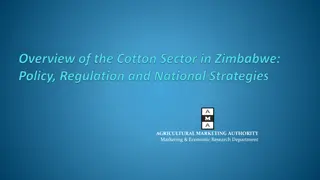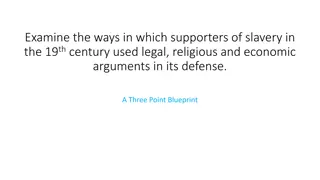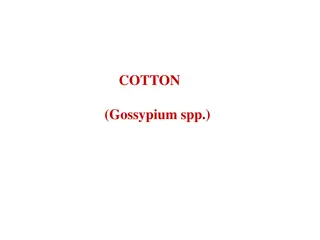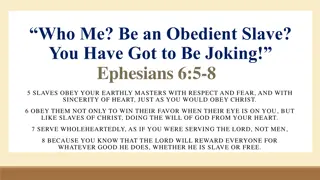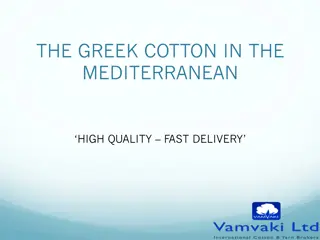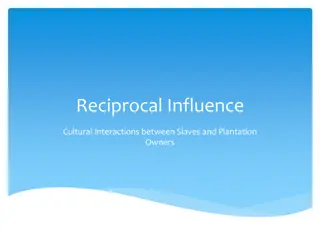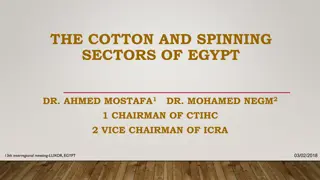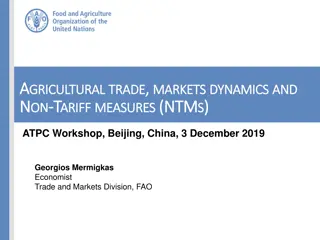Development of Slavery and Cotton Economy in the Agricultural South
The development of slavery and the rise of the cotton industry in the Agricultural South played a crucial role in shaping the region's economy and society. From the introduction of crops like tobacco, rice, and indigo to the emergence of cotton as a dominant crop supported by innovations such as the cotton gin, the South became a major producer of cotton, driving its economy and leading to a significant reliance on slavery. The expansion of other food and cash crops, along with the societal structure characterized by different social classes, further defined the dynamics of the Southern society during that era.
Download Presentation

Please find below an Image/Link to download the presentation.
The content on the website is provided AS IS for your information and personal use only. It may not be sold, licensed, or shared on other websites without obtaining consent from the author.If you encounter any issues during the download, it is possible that the publisher has removed the file from their server.
You are allowed to download the files provided on this website for personal or commercial use, subject to the condition that they are used lawfully. All files are the property of their respective owners.
The content on the website is provided AS IS for your information and personal use only. It may not be sold, licensed, or shared on other websites without obtaining consent from the author.
E N D
Presentation Transcript
The Agricultural South The Development of Slavery
Pre Revolution crops- Tobacco, Rice and Indigo Cotton Not profitable Difficult to remove seeds 1 pound per person per day Industrial Revolution Causes need for cotton Textile industry Cotton Gin-Machine that removes from short staple cotton Eli Whitney (1793) Planters- farmers that held 20 or more slaves Built large cotton gins Could process tons of cotton faster and cheaper Southern Economy (Cotton)
Cotton Gin Eli Whitney (1793)
Cotton Boom United States produced half of the worlds cotton in 1840. 2 million pounds in 1791 1 billion pounds in 1860 Cotton belt-Area of high cotton production Cheap to grow, non perishible, easy to transport Destroyed soil Cotton requires labor Farmers turn to slavery
James Henry Hammond (South Carolina)- claimed the worlds economy would fail without cotton production. Felt the south was the most important region in the world Factors-crop brokers who bought and sold cotton Arranged loans for farmers Helped farmers with investments Arranged transport of cotton "Cotton is King!!" Transportation in the south is limited Depended on rivers to move products Steamboats become primary source of transporting goods
Food and Cash Crops Industry Encouraged southerners to expand their crops (not just cotton) First steam powered sawmill- Louisiana Other Crops and Industry Corn-top 3 corn growing states located in the south Small number of cotton mills developed Other crops-tobacco Drying process developed tobacco growth Tredegar Iron Works-One of the most productive iron works in the nation Most in the south focused on agriculture Hemp, flax, rice, sweet potatoes, wheat and sugarcane.
Southern Society Only 1/3 of white southerners owned slaves Social classes include- planters, yeoman farmers, poor whites, slaves and free African Americans. Planters Wealthiest Members in the south Men ran farm Women ran the house Slaves cooked, cleaned and raised the children Some weddings were arranged
Yeoman-Owners of small farms Owned few slaves or none Free African Americans About 250,000 lived in the south in 1860 Most worked as paid laborers Discriminated against Could not vote, travel freely, or hold some jobs Free African Americans were thought to threaten the institution of slavery Poor Whites Lived on land unable to grow cash crops Other Southern Social Classes Urban Life African American stayed connected through church and social gatherings Had to hire a white person to make business transactions on their behalf
Working in the field Gang Labor- many people doing the same task at the same time Worked from sun up to sun down (Most did not get lunch breaks) Worked despite the weather or illness Big House Worked as butlers, cooks or nurses Had better food, clothing and shelter Had to be ready to work 24 hours per day The Slave System Skilled labor Blacksmiths and carpenters Some allowed to hire out and make money
Slaves viewed as property not people Punishment Punished in front of other slaves Whipping, stocks, wear irons, placed in a hole for weeks. Most were sold at auction Some free African Americans were kidnapped and forced into slavery Life Under Slavery Living conditions Poor Dirty floors, leaky roofs Cheap fabric clothing Some allowed to have a garden for food Slave Codes No traveling Literacy laws No group meetings
Family Family more important than punishment At auction families could be separated Family stories were told to maintain history Folktales-Stories with a moral (often involved a trickster) Work Day 3AM Out of bed, Tend to Animals 6AM Prayers 7AM Start Work 12PM Lunch 1PM Return to Work 7 PM Dinner 8PM Return to Work 11PM Lights Out Slave Culture
Most slaves were Christians Saw themselves as God's chosen people (Hebrews in the Old Testament) Sang Spirituals- emotional Christian songs that blended African and European music Forced to worship out of the eyes of Slaveholders Religion Rebellion Some worked slower to avoid work Some ran away for short periods (visit families) Escape to the North meant risking severe punishment or death
Some were discovered before they happened: Denmark Vesey (1822) and Gabriel Prosser (1800) Nat Turners Rebellion (1831) Believed that God had told him to end slavery (He is a slave) Led a group of slaves to kill all the slaveholders and their families They killed 60 people in the community 100 innocent slaves killed to stop the uprising Nat Turner is on the run for 6 weeks He is captured and executed Caused more strict slave codes to be enacted Slave Uprisings
Abolition-complete end to slavery Abolitionist-Individual who opposes slavery Quakers- oppose slavery on religious grounds (We are all equal in Gods eyes) Some used the Declaration of Independence as an argument Some wanted equal rights for slaves-Others just wanted to end slavery Liberia-Colony established for former slaves (12,000 African Americans settled the area) The Movement to End Slavery
William Lloyd Garrison Angelina and Sarah Grimke Wrote an Abolitionist Newspaper-The Liberator (1831) White Southern women Spreading the Abolitionist Movement Angelina wrote- Appeal to the Christian Women of the South(pamphlet) Founded the American Anti Slavery Society (1833) Sisters wrote American Slavery As It Istogether (book) Involved Free African Americans in the cause Petitioned congress for change.
William Lloyd Garrison I am in earnest - I will not equivocate - I will not excuse - I will not retreat a single inch - and I will be heard! William Lloyd Garrison
Frederick Douglas Sojourner Truth Other Important Leaders Escaped from slavery at the age of 20 Former slave Key speaker for the abolitionist movement as well women's rights. Outstanding public speaker Got involved with the Anti Slavery Society Gave fiery and dramatic speeches Published a newspaper called North Star
Frederick Douglas The life of the nation is secure only while the nation is honest, truthful, and virtuous. Frederick Douglass
Underground Railroad- a network of people who arranged transportation and hiding places for escaped slaves and fugitives Composed of Free African Americans, Former Slaves and white Abolitionists Helped on routes to the north and Canada "conductors" - People that helped along the route (Harriet Tubman) "stations"-stopping points along the route "station masters"-abolitionists who provided shelter Harriet Tubman helped 300 slaves escape over 19 trips to the south The Underground Railroad
Many Northerners supported slavery Feared that free slaves would move north and take their jobs Some joined mobs and killed abolitionists Abolitionist Opposition Congress enacted a "gag" order to refuse speaking about slavery John Quincy Adams pushed to remove the gag order successfully Southerners Punished people for speaking out against slavery Grimke sisters were forced to leave South Carolina
